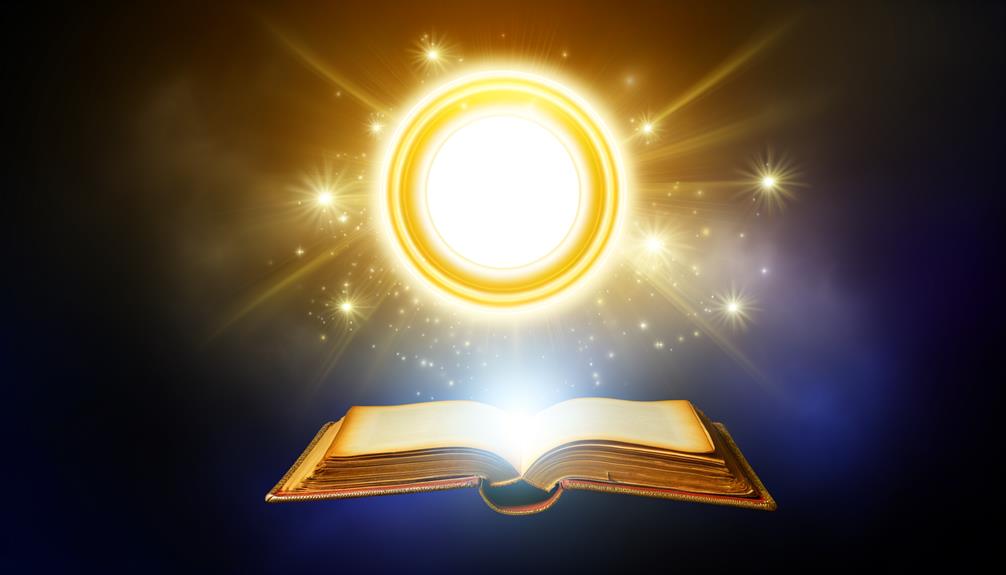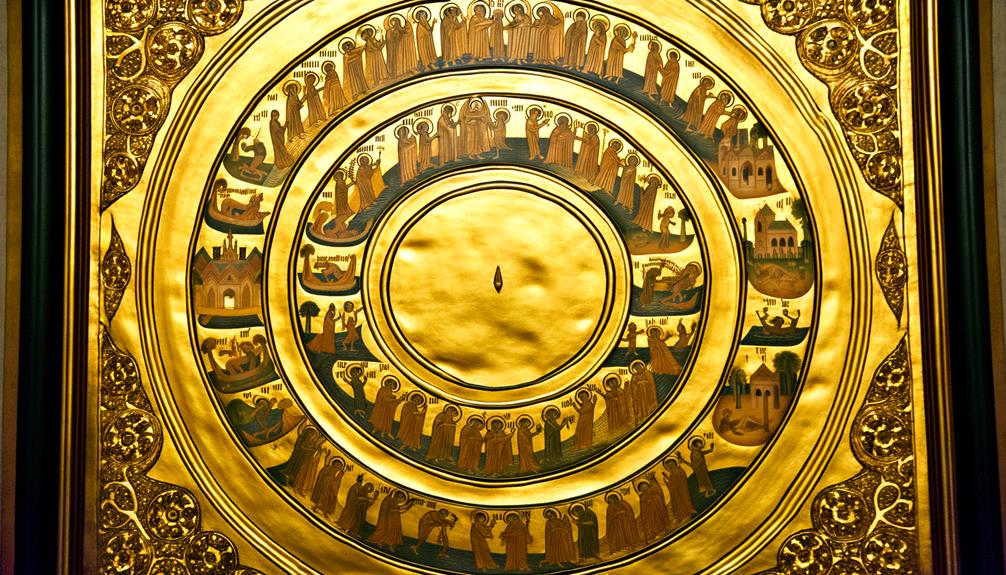Circle In The Bible Meaning: Eternity and Unity
In biblical symbolism, the circle profoundly represents eternity, divine perfection, and the unity of God’s creation. It reflects the infinite nature of God as seen in passages like Isaiah 40:28 and Revelation 1:8, highlighting His timeless existence and perpetual sovereignty.
The circle also symbolizes wholeness and inclusivity within the Christian community, mirroring the unity Christ prayed for in John 17:21. Additionally, the cyclical patterns in scripture, such as Israel’s cycles of faithfulness and redemption, denote life’s interconnectedness and the human need for divine grace.
Such layers of meaning provide deeper insights into the theological essence of biblical teachings.

Circle Meaning in the Bible: Symbolism of Eternity and Divine Order
| Aspect | Explanation |
|---|---|
| Definition | A round shape with no beginning or end |
| Biblical Usage | Symbolizes completeness, eternity, and divine authority |
| Key Verses | Isaiah 40:22 – “He sits enthroned above the circle of the earth…” |
| Symbolic Meaning | Represents God’s infinite nature and perfect creation |
| Spiritual Lesson | Reflects divine wholeness, unity, and the eternal nature of God’s plan |
Eternity and God’s Nature

The symbol of the circle in the Bible poignantly represents the concepts of eternity and the infinite nature of God. This geometric shape, devoid of a beginning or end, mirrors the scriptural depiction of God as eternal and unchanging.
For instance, passages in Isaiah 40:28 and Revelation 1:8 emphasize God’s timeless existence and omnipresence. The circle’s continuous loop is emblematic of God’s perpetual sovereignty, transcending temporal confines.
Moreover, the circular form is often interpreted as a visual metaphor for divine perfection and completeness, encapsulating God’s omnipotence and omniscience. Consequently, the circle serves not merely as a symbol, but as a profound theological statement about the enduring and boundless essence of the divine in Christian thought.
Unity in Christian Fellowship

Extending beyond the representation of divine eternity and perfection, the circle also embodies the unity and interconnectedness inherent in Christian fellowship.
The circular form signifies the wholeness and inclusivity of the Christian community, emphasizing that all members are equally crucial within the Body of Christ. This symbolism is essential in understanding how believers are to live in harmony, support one another, and work collectively for a common purpose. It underscores the interconnected nature of Christian relationships, reflecting the unity Christ prayed for in John 17:21.
- Inclusivity: Every member, regardless of status, is integral to the fellowship.
- Equality: Each person’s role is valued, mirroring the egalitarian structure of a circle.
Cyclical Patterns in Scripture

Within the biblical narrative, cyclical patterns emerge as a profound motif, reflecting the recurring themes of renewal, judgment, and divine intervention throughout salvation history.
These patterns are evident in the repetitive cycles of Israel’s faithfulness, rebellion, and subsequent redemption. For instance, the Book of Judges underscores a cycle where Israel repeatedly falls into sin, faces oppression, cries out to God, and is delivered through divinely appointed judges.
Similarly, the prophetic books emphasize cycles of judgment and restoration, illustrating God’s continuous call to repentance and His unwavering commitment to His covenant.
These cycles are not merely historical recountings but serve as theological reflections on the human condition and the perpetual need for divine grace and intervention in the journey toward redemption.
Divine Perfection and Wholeness

The circle, as a geometric figure, holds profound symbolic significance in the Bible, representing divine perfection and wholeness.
This shape’s endless continuity mirrors the eternal nature of divine completeness, suggesting an unbroken and infinite divine presence.
Such symbolic Biblical geometry underscores the theological concept that God’s perfection is both unbounded and all-encompassing, reflecting His eternal and omnipresent nature.
Symbolic Biblical Geometry
In the context of symbolic biblical geometry, the circle frequently represents divine perfection and wholeness, encapsulating the infinite nature of God and the completeness of His creation. This geometric shape reflects theological principles, illustrating the continuity and unending nature of divine attributes. The circle’s inherent lack of beginning or end symbolizes eternity and God’s omnipresence.
- Creation and Completeness: The circle can signify the entirety of God’s work, echoing the completeness of creation as described in Genesis.
- Divine Presence: Circles often symbolize the omnipresence of God, communicating His eternal existence throughout all domains.
This geometric symbolism provides profound insights into understanding biblical teachings.
Eternal Divine Completeness
Frequently, the representation of a circle in biblical texts serves as a profound symbol of eternal divine completeness, emphasizing God’s perfection and the wholeness of His creation.
The unbroken, continuous nature of a circle mirrors the infinite and unchanging essence of the divine. Scriptural references, including Isaiah 40:22, which describes God as ‘enthroned above the circle of the earth,’ reinforce this concept of totality and eternal sovereignty.
The circle’s geometric simplicity yet profound depth embodies the harmonized unity within God’s creation, suggesting an interwoven, interconnected reality. In this way, the circle becomes a theological metaphor, encapsulating the divine attributes of omnipotence, omniscience, and omnipresence, ultimately reflecting the transcendent, boundless nature of God’s divine order and purpose.
The Circle of Life

Embodied in various scriptures, the concept of the ‘Circle of Life’ often symbolizes the interconnectedness and cyclical nature of existence as depicted in the Bible. This notion is intricately woven into the narrative fabric of biblical texts, illustrating the perpetual cycles of life, death, and rebirth.
Through an analytical lens, the ‘Circle of Life’ in the Bible can be interpreted in several ways:
- Creation and Renewal: The recurring theme of creation, destruction, and renewal demonstrates the continuous process of life.
- Generational Legacy: The genealogies in scripture emphasize the importance of lineage and the perpetuation of life.
These elements collectively underscore the divine orchestration of life’s cyclical patterns.
Symbolism in Biblical Covenants

The symbolism inherent in biblical covenants serves as a profound proof to the binding and sacred agreements between God and humanity.
Throughout scripture, covenants are often sealed with symbolic acts or signs, such as the rainbow in the Noahic Covenant (Genesis 9:12-17) or circumcision in the Abrahamic Covenant (Genesis 17:10-14). These symbols reinforce the perpetual and divine nature of these agreements.
The circle, as a symbol of eternity and unity, can be interpreted within this context to signify the perpetual nature of God’s promises. This unbroken form represents the everlasting commitment of God to His people.
Consequently, the circle becomes a powerful emblem of the eternal, unending bond that covenants represent in the biblical narrative.
Conclusion
The representation of the circle within biblical texts encapsulates a profound convergence of themes: eternity, unity, cyclical patterns, divine perfection, and the circle of life.
This symbolism extends to the covenants that frame the relationship between the divine and humanity.
The circle’s appearance across various contexts underscores its multifaceted significance, inviting deeper reflection on the divine attributes and the holistic nature of biblical theology.
Accordingly, the circle serves as a compelling emblem of interconnected spiritual truths.






